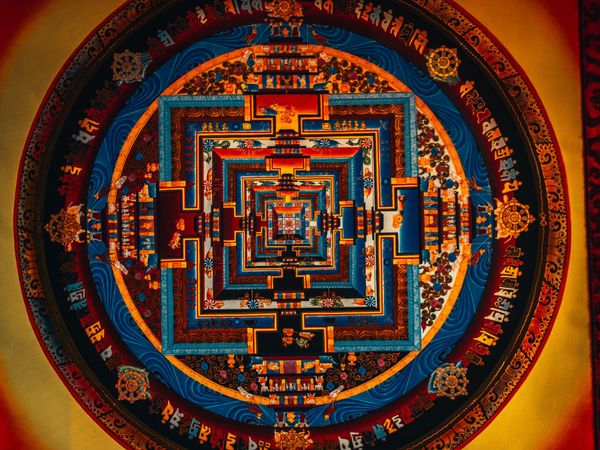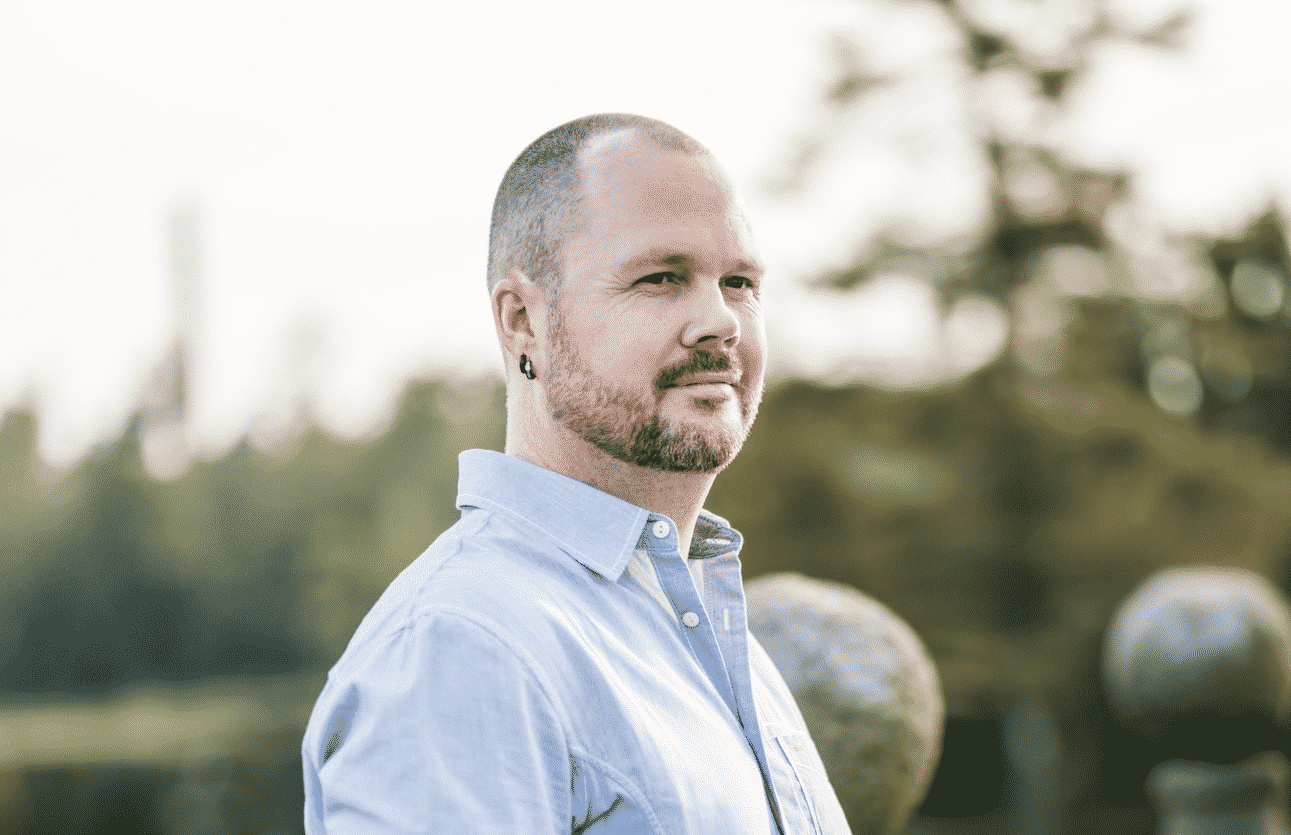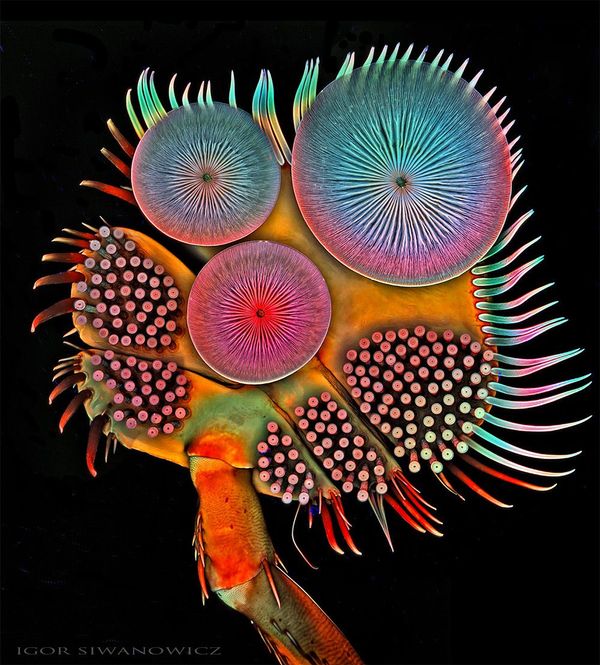Alexander Zaitchik • • 20 min read
From College Dropout to Shaman Apprentice: A Story of Becoming a Leader of the Secoya and Protecting the Vanishing Amazon
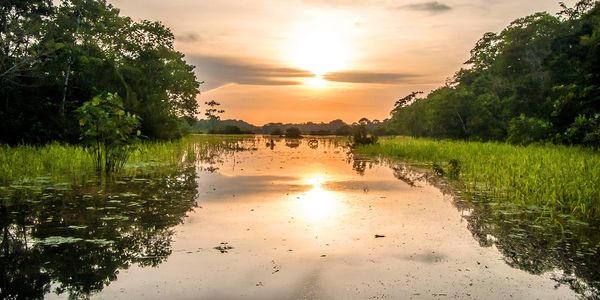
I first heard about Luke Weiss from an elder of the Waorani, a tribe scattered along the Amazon tributaries of northeastern Ecuador. He spoke of a white man living with the Secoya, a small tribe settled on a nearby river, but one who had ceased to be a white man. This man had become Secoya. He practiced the tribe’s oldest and most difficult traditions. He spoke a pure, antiquated Secoya dialect. What’s more, he had achieved something no outsider ever had among the tribes of the region: He became apprentice and heir to the tribe’s renowned healer, a 103-year-old shaman named Don Cesario. When people from local villages and distant towns seek out Cesario for healing, it is Weiss who prepares the ritual potions.
I asked where I could find this gringo, and the old man sketched a map in the dirt showing a daylong trip down the tributaries of the Rio Napo.
Late the next afternoon, I arrived by motored canoe in San Pablo, a riverside hamlet of 600 Secoya not far from Ecuador’s border with Peru. Villagers told me that Weiss, whom they call Lucas, was expected back that afternoon from a weeklong hunt with his family. They led me to a sandbar where women were washing clothes with bars of soap and told me to wait. Just after dusk a canoe appeared at the bend. Helming the motor was a white man, the first I’d seen in a summer traveling among Ecuador’s northern tribes. He looked lithe and boyish, younger than his 39 years. A broad-faced native woman sat in front of him, behind two little girls at the bow.
As the canoe neared the bank, he cut the engine, leaped out, and heaved the craft onto a jetty of river muck. He lifted an old Russian side-by-side shotgun and pulled back a tarp to unveil a bounty of jungle meat: boar-like peccaries, woolly monkeys, and pacas, cat-size nocturnal rodents that the local tribes call wanta and keep as pets or put in their soup. The man and the woman exchanged a few words in Pai’koka, the Secoya tongue, and she led the girls down a forest path.
Only then did the man, barefoot and muddy to his knees, approach me with an open hand. “I’m guessing you’re completely lost,” he said. “Or you’re the guy I heard was looking for me.”
The history of outsiders in the northern Amazon is not a happy one. Conquistadors, rubber barons, missionaries, and, more recently, oil and mining companies, make up a tradition of forced conversion and violent plunder. The five migratory hunter-gatherer tribes of Ecuador’s Napo River region — the Secoya, Cofan, Waorani, Kichwa, and Siona — earned their hostility to outsiders by the early 1960s, when the Ecuadoran army swept into the forest and forcibly settled the tribes in advance of Texaco, which had been contracted by the military junta in Quito to map and drill the region’s heavy crude. A few clans retreated deeper into the forest, where even today dwindling pockets of their “wild” descendants remain. But most ended up in concrete-and-thatch reservation villages like San Pablo, which lies on a small patch of jungle crowded on all sides by oil blocks that bleed poison into the rivers, send roads into shrinking hunting grounds, and bring in contract workers who occasionally rape local Indian girls.
With this history in mind, how did a college dropout from Michigan enter a tightly knit tribe and not only overcome distrust but also assume a position of leadership? “It was a process, on both sides. I was just traveling, trying to figure things out, when I found this place,” Weiss said over candlelight as his wife, Yamira, served monkey with rice and yuca in the high-stilted smokehouse next to their riverside home. He punctuated his thoughts with long ellipses in the staccato, oddly musical rhythm of Secoya speech. “I didn’t know where I was going,” he said. “Then one day, so long ago I don’t remember it, it was home.”
During dinner, a faint motor would occasionally rumble against the faint noise of villagers socializing upriver on the opposite bank, home to the schoolhouse, a soccer pitch, and a ramshackle stall that sells wafer cookies and warm soda beside a giant caged boa. Befitting a shaman’s apprentice, Weiss lives at a remove, next to the leaf hut where he and his teacher, Don Cesario, oversee rituals involving ayahuasca, the famous hallucinogenic healing plant known locally as yage.
Yage is just one part of the Secoya tradition under siege. “The forest is shrinking and overhunted,” Weiss said. “If you look at a satellite image, we have 40,000 hectares in this little green box, surrounded by the gray of industry. You can see Secoya territory by the vegetation. But it’s fragmented, bisected with roads. If you go off hunting and come back empty-handed, the kids are hungry. What are we going to do? People are cutting down trees even though they don’t want to, because there’s money in growing African palm,” he said, referring to the pesticide-dependent cash crop used to make palm oil, which is the biggest industry in the region after petroleum.
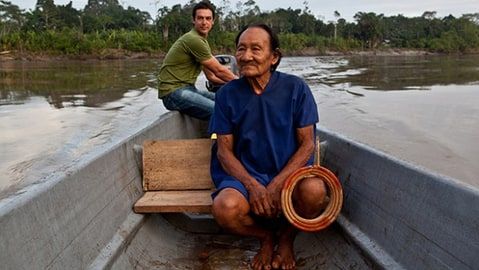
Motoring on the Aguarico River with his wife’s grandfather. By Mitch Anderson.
After the meal, Weiss put his girls to bed and returned with a tin of coffee and two fresh candles. “You’re lucky you came when you did,” he said. “I fly out of Quito on Monday. Classes start next week.”
Weiss, it turns out, is about to enter his second year of a master’s program at the Yale School of Forestry. His research project: figuring out how to cultivate yoco, a caffeinated vine that suppresses appetite and provides a sustained energy boost, making it the go-to energy drink of the northern Amazon. Weiss wants to crack yoco’s code. If it can be cultivated more easily at scale and turned into a marketable drink like yerba maté, then yoco could become a viable, sustainably produced cash crop — and the Secoya’s only chance for cultural and economic survival. Young Secoya are leaving San Pablo for the cities or taking jobs with the oil companies. Because the tribe has few practical alternatives, there is a growing resignation among members to lease their land to polluting industries. It adds up to an existential threat to the ancient Secoya culture for which Weiss has become an unlikely champion. As the elders begin to pass away, Weiss is among only a handful of younger Secoya committed to keeping alive their knowledge and rituals, including the most difficult and demanding of Secoya traditions, from hand weaving hammocks with palm twine to undergoing the grueling discipline required for shamanic training.
“I’d rather not be living in New Haven,” Weiss said of the academic year ahead. “But it’s an emergency situation down here. We need alternatives. We need allies.”
Weiss grew up in Redstone, Michigan, a small town just north of Lansing, the middle child of three. He was a dirty kid, the kind who traipsed through swamps past dusk catching salamanders. “I was always coming home muddy and late for dinner,” he says. He was close to his two loving parents, ran varsity track in high school, and enrolled at Michigan State to study zoology. But college life bored him. “I realized I hadn’t seen anything, hadn’t done anything,” he says. After his sophomore year, he quit and hit the road.
He went south: Mexico, Costa Rica, Panama, Colombia. In early 1996, he arrived in Quito, though soon grew tired of the expat party, which was too much like the college scene in Michigan he had left behind. Some fellow backpackers told him about a project they’d heard about a few hundred miles east, in a remote village near the Peruvian border. A Secoya shaman was seeking volunteers to build an eco-lodge and a garden to preserve the tribe’s ethno-botanical heritage. The shaman in charge of the project, Don Cesario, was said to be strict but also bighearted and jolly. He was famous throughout the area for both his strong pots of yage and his eccentric fashions, which included feathered crowns. He also layered Mardi Gras beads over bright tunics and wore a baseball hat declaring yo soy el mejor (“I am the best”).
“As soon as I heard about the project, I headed east,” says Weiss. “There were a few people there when I arrived, but it was a rotating cast.” Many of the volunteers were drawn less by the lodge than by Cesario’s famed pots of yage. “There were a lot of characters,” Weiss says. “One French kid showed up wearing nothing but a backpack and tighty-whities.”
The backpacker volunteers under Cesario’s direction collected leaves from swamps and cleared brush with machetes. They ate communal meals of rice and yuca and slept in hammocks. Every couple of weeks, they drank yage — which triggered physically wrenching visions at turns sublime and hellish. But Weiss found that yage gave him strength for the long days of work. It also helped him get in tune with the jungle, which he explored on long, often barefoot treks.
After a couple of months, the volunteers had drifted back to the backpacker trail. Only Weiss stayed. He lived in the thatched-roof hut he helped build next door to Cesario and his wife, Doña Joaquina. (Don and Doña are Spanish titles often reserved for healers in the region.) He and Cesario fell into a natural rhythm: They rose before dawn to drink gourds of banana gruel and yoco and to comb their dreams for omens before entering the jungle. “Erotic dreams bode well,” says Weiss. “Dreams of hooking fish augur snakebites, so you stay home.” After breakfast, they tracked game, marked trails, and studied the plants. At night, Weiss borrowed Cesario’s old muzzleloader and hunted wanta.
As Weiss’ relationship with Cesario deepened, the old man began calling him hijo, or son. Weiss relished life in the jungle: rising in the dark, the honest hard work, the sonic and tactile delights of the rain forest. And the more yage he drank, the more he began to feel that the kid who left Michigan had found his native soil.
Of course, not everything came naturally. “It took me years to learn to hunt,” Weiss says. “Especially at night. My aim was bad. I didn’t understand the animals. I’d go out for 10 hours and come back with nothing. There was a lot of teasing.” Finally, on one evening hunt, Weiss landed his first wanta. “When I came back to Cesario’s, everyone was so excited for me. They started boiling water and cooked it up right then, at like 3 am, and we had a party.”
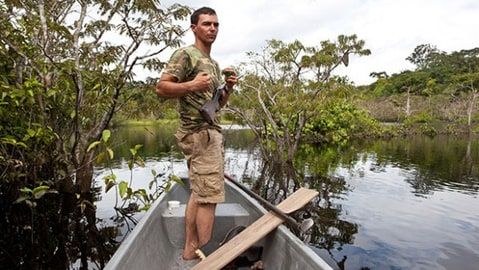
Weiss, hunting on Ecuador’s Napo River. By Mitch Anderson.
Cesario’s stature helped shield Weiss from community suspicion and resentment. Still, his acceptance was a process. “During my second year, when I started hunting on my own, there were some people who said, ‘He’s been here too long. Who’s this gringo shooting our boar?’ Cesario and his wife defended me, saying, ‘The boar he shoots goes on eight plates. He doesn’t eat much.’ ”
Soon the grumblings stopped, replaced by a kind of wonder. What kind of gringo chooses a hunter gatherer lifestyle in the middle of the woods and prefers traditional plants to Western medicine? “They noticed I wasn’t taking pictures or notes like every outsider they’d met,” Weiss says. “I wasn’t surveying the land, keeping a journal to write a book, or trying to get knowledge and information to exploit. They saw me as being in the same groove as them — getting up early, working hard, not asking a lot of questions. Like them, I loved hunting boar and spearfishing at night.”
In 1999, after nearly two years in San Pablo, Weiss fulfilled a promise to his mother to finish his college degree. He enrolled at Evergreen College in Olympia, Washington, and paid for school in part by digging clams on the Washington coast, all the while pining for the rain forest. “One thing I really missed was going hunting to satisfy my hunger after a day’s work,” he says. “You never really get hungry in the States, where there’s always something in the fridge.”
After graduating with a bachelor of science in biochemistry, Weiss returned to San Pablo, moving in to his leaf-and-pole hut and resuming his studies under Cesario, to deepen his knowledge of the forest and the ancient but fading Secoya traditions.
None of this came as much of a surprise to Weiss’ mother, Nancy Knudsen. “He’s an adventurer,” Knudsen said. “But it took me a number of years to really understand what was evolving for him.”
Weiss still gets ribbed for being a weirdo by some Secoya, among them his wife, Yamira. A few years ago, he took his young family to the regional capital, Lago Agrio, to sell chickens and plantains at a street market. Except for his pallor, Weiss looked like every Indian farmer hawking his wares in the city. Observing her husband, Yamira could only laugh. Kissing him, she uttered a nickname that stuck: mi gringo falso.
Shamanism has never been a popular career choice among the Secoya. It’s a difficult path, requiring ascetic discipline and regular, grueling, multiday trials under the influence of the strongest hallucinogens in the natural world. Cesario accepted Weiss’ apprenticeship only after he had demonstrated mental and physical toughness and an absolute commitment. “Bit by bit, Cesario taught me how to bring the mojo into the pot, how to collect the firewood, the water, the leaves, the vines,” Weiss says. “The ceremony is just the culmination of a long, careful process of fasting, pulverizing, stripping, cutting, cooking.”
It was during the yage ceremonies that Weiss started learning Pai’koka. The elders’ chanting, he says, opened up the language as if it were already there inside him: “After a ceremony, I’d wake up at night speaking Pai’koka in my dreams. It’s hard to understand unless you’re in that space, but on yage you can see the words and their meaning.” Weiss didn’t just learn Pai’koka, he learned an ancient variant no longer in common use.
After yage, the most important vine in traditional Secoya life is the subject of his Yale research: yoco. It was a significant, though self-serving, honor when Cesario tasked Weiss with preparing his predawn rain forest red-eye, an arduous process involving stripping the woody vine, then rasping and kneading the pulp with water in a gourd.
Throughout his training, Cesario required celibacy of his student. This likely displeased the Secoya girls, who blushed in the presence of Weiss’ exotic good looks. But they didn’t see him often. Weiss and Cesario lived a long paddle downriver from where most Secoya socialized. “Cesario didn’t like me going to mingas (Secoya barn raisings), drinking chicha (fermented yuca), or generally being around women,” Weiss says. “We had to be removed from the community.” During his twenties, Weiss’ social life consisted of tutorials with his teacher, yage ceremonies with elders, and hunting trips with Cesario’s grandson, José.
Weiss’ arrival in the territory coincided with the Secoya’s vote approving preliminary seismic testing for oil on tribal land. From his first days among the tribe, the shadow of oil development has hung over life in San Pablo. Cesario, representing the minority view, has always been against the oil deals, convinced the activity will destroy the forest and weaken his power to call in spirits. “Cesario believes industry in the area creates static,” Weiss says. “That it is severing the old lines of communication.”
One night during a yage ceremony, Weiss remembers, Cesario exploded in a rare fit of anger, promising to use his powers to conceal oil from the oil companies. “I’ll cover it up!” he thundered. “I’ll push it farther into the ground. I’ll bury it so deep they’ll never find it.”
In 2002, Cesario organized the trip Weiss calls “the greatest adventure of my life.” Together with another nonagenarian, Belisario, they traveled to a patch of raw jungle on the border, where they joined one of Cesario’s Peruvian cousins. The plan was to lay the groundwork for a new Secoya community away from the oil companies. Getting there required eluding Doña Joaquina, who didn’t want to be left behind by her then 95-year-old husband. “When we floated by her, she was glaring at us, just very pissed off,” remembers Weiss. “Cesario was laughing, waving ‘Ciao!’ I couldn’t even look at her.”
They were gone for three years. They slept on beaches, ate fish with salt, and hunted for turtle eggs. Over time, they cleared and burned enough jungle to plant yuca and plantains and build dirt-floored huts. “It was just me and these 90-year-old men, who I love and respect very deeply, fishing, hunting, doing yage, and working all day,” says Weiss. “I’ve never had so much fun.”
They returned in 2006, with little more than a sketch of the planned village, when Weiss, then 30 years old, broke the news to his mentor: He was ready to leave his side and join Secoya society. Weiss could now hunt, build, farm, and speak Pai’koka. He knew more about the forest and tribal traditions than most Secoya. He was also more than ready to end his celibacy. A hunting and yage friend had blessed his request to marry his sweet and confident 18-year-old daughter, Yamira. “Most of the girls were shy around me,” says Weiss. “But not her. She was special.”
The old shaman did not hide his displeasure. Cesario told his protégé that healers should remain unattached, set apart. He said that he had only married against his will, in his late thirties, due to complex family obligations. “When I left, we didn’t speak for some time,” says Weiss. “Doña Joaquina held a grudge, too.”
Weiss’ father came from Portland, Oregon, to the wedding, during which the betrothed were surrounded by a circle of elders offering advice on domestic life and productive gardens. Gerald Weiss was taken with his new daughter-in-law and the Secoya. (“We’re talking about building my dad a hut to spend part of the year in, now that he’s retired,” says Weiss.) The next day, Weiss started building his family home on the quiet side of the river. Seeking a role in community affairs, he was elected tribal secretary of education and culture, a post he held for four years. During that time, Weiss argued for a cautious approach to development issues.
Weiss continued his work with Cesario. And after completing his home, Weiss constructed a nearby yage hut overlooking the river. Impressively built, the open-walled, heavily thatched-roof structure is centered by a fire pit and decorated with a jaguar skull, a shamanic totem throughout the Amazon. Here Weiss and Cesario host ceremonies once or twice a month. The participants are a mix of Secoya, visitors from other tribes, and mestizos from nearby towns and distant cities. “Colonists from Coca and Lago Agrio often show up asking Cesario to cure an ailment,” says Weiss. “Kids can drink at any age, as long as they ask for it. I recently drank with a six-year-old girl.”
Cesario maintains a regular drinking schedule into his hundreds. Indeed, he believes yage is the elixir for a long and healthy life. When Cesario does eventually pass, his role and responsibilities will fall to a group of three Secoya that includes his adopted Michigan-born son. Without denying his future role, Weiss bristles at the title “shaman.”
“I would never use that word,” he says. “I drink yage. It’s a way of life. When I’m older, people will come to me for healing. But most elders say there’s no ‘graduation.’ The word doesn’t exist in Secoya. You just keep drinking. ‘Shaman’ is something other people call you.”
I ask about Cesario’s yo soy el mejor hat.
“Ah, Cesario is a special case,” he says, breaking into a smile. “We’ll visit him tomorrow.”
At daybreak, we emerge from Weiss’ canoe to find Don Cesario waiting for us above the high bank. He’s sitting in a wheelchair outside his hut, smoking raw black tobacco held together with plantain leaves. “I knew you were coming,” says Cesario. “I saw you in a dream last night.” He and Weiss gently touch hands, a sign of respect, and say, “pai’ke,” which means “Are you alive?” (“It doesn’t really translate well,” says Weiss.)
We enter Cesario’s hut, and Weiss begins to rasp a yoco vine for his teacher, as he’s done so many times. As the first gourd is passed around the room, there is small talk about the practical aspects of Cesario’s failing health, such as his need of a hearing aid. “A big one,” says the old man. “The little ones you can lose in your soup.” He also wants to build a concrete path to the riverbank so he can spend his days watching the passing Aguarico. Cesario says he can feel himself drifting into the spirit world. “But I won’t die until I’m 120, like my grandfather,” he says.
I ask Cesario about the yage ceremony that preceded the recent hunt. The August drink is one of the biggest of the year, so intense that participants usually take a break for a month or two before or after. Every August, a constellation appears in the Ecuadoran sky in which the Secoya see a canoe, called Caco’huito’yai. This astral skiff is a vessel for animal spirits. “When the constellation is in position, we take strong yage and call forth the animals,” says Cesario.
Before big hunts, Weiss slurps down a powerful semisolid yage that translates as “honey.” The viscous sludge is stronger by magnitudes than standard brew, requiring weeks of preparatory fasting and purging. “Putting it down is torturous,” says Weiss. “When you throw it up, you catch it in a bowl and try again. It comes on fast — an intense, noisy channel, full volume, that goes into the next day. It’s not pretty butterflies. It’s not recreational.” Beyond honey is pehe: yage stewed with toxic Brugmansia blossoms, which is known to gardeners as angel’s trumpet. The jaguar of natural hallucinogens, the flowers can be fatal when not cooked properly. Weiss was years into his training before he requested pehe. Cesario told him to plant the flowers, giving him a year to prepare while they grew. When I ask Weiss to describe pehe, his eyes widen and he cocks his head. “Let’s put it this way: After two days, you drink ‘honey’ to get your sight back, to start coming down. It culminates initiation into visionary states. People turn to it as a last resort — if they can’t get over the drowning of a child. Most people call it quits after one experience.” Weiss has consumed pehe twice. Cesario, six times, the most among living Secoya.
Fewer young Secoya have interest in these traditions. This saddens Cesario. A chasm has opened between his generation, which was born free inside a vast and borderless forest, and those born into the permanent settlement of San Pablo. I ask what it means to him that Weiss will keep the flame of the old ways. “Lucas came from far away, and from the beginning showed a love for our culture and a desire to learn,” he says. “He became a Secoya. If the rest of the youth had the love for the culture that he does, we’d be much stronger.”
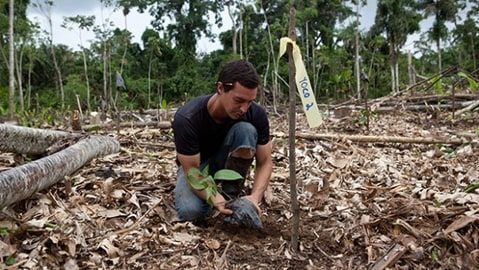
Weiss plants yoco, the caffeinated vine that is the coffee of the northern Amazon. By Mitch Anderson.
Two mornings before he leaves for New Haven, I help Weiss clear brush around the plot behind his house, where he grows yuca, plantains, fruits, and corn to feed dozens of chickens. A few stout palms provide the chambira twine for weaving. “You need a mile of string for one hammock,” he says. “It takes months of twining. As you can imagine, not too many youth are picking up the skill.” During our work, several wasps attack Weiss’ face and neck after he whacks a nest. His expression barely changes during the attack. “Another thing about yage is it helps you deal with pain. The old guys say bee stings give you strength.”
As the morning sun begins to beat down, I ask if he misses anything about living on a modern grid. He pauses. “There are times,” he says, “working out in the field on a hot day when I really miss a cold glass of water.”
In a few days, Weiss will have cold water, if not the thirst needed to enjoy it fully. He’ll spend his days in classrooms, libraries, and high-tech labs, researching the biochemistry of yoco. He hopes the vine can be developed into a cultural bridge between Cesario’s generation and younger Secoya, who are forced to find their way in a global economy with limited resources and land, where the old ways of life are neither possible nor desirable.
“People have this false romantic image of indigenous people living under trees in the forest,” says Weiss. “We understand there’s no going back. We have a yearning to merge with society without losing our culture and the integrity of the forest. We don’t see it as one or the other.” Not far from us, Weiss’ daughters are playing with dirty dolls on the riverbank. Weiss speaks English to them at home; the elder of the two is already trilingual. (They’ve spent a year in New Haven, and Weiss teaches her English at home.) It’s easy to imagine the girls one day leading the modern-traditionalist movement their father hopes to nurture. It’s just as easy to imagine them moving to Lago Agrio or Quito, away from a beaten culture, a poisoned river, and barren forests.
But Weiss is optimistic. “I think the kids leaving now will realize they had a good thing back in the territory,” he says. “A lot of them come back. Hopefully, they’ll fight to protect what’s left here, before it’s gone.”
On a bitingly cold late afternoon in February, I visit Weiss at Yale. It’s been six months since we met on the Aguarico. He pulls up in front of my downtown New Haven hotel, in an old Saturn on loan from a fellow student. The winter has been nasty even by the standards of his native Michigan. “The girls love sledding, but we’re all ready to go back home,” he says. As we drive toward his lab, he describes events beckoning him to San Pablo: The oil companies have found their oil and are pushing more drilling contracts. His mother-in-law is seriously ill with parasitical worms. On the family farm, his fruit palms are blooming, and they are missing the harvest.
We park alongside a snowdrift outside Yale’s Environmental Science Center, and Weiss leads me to his third-floor lab. The room is crowded with beakers, micro-scales, and plastic jugs with hazmat warning labels. He shares the space with a half dozen other students, including one who is researching mercury levels in the hair of indigenous Peruvians who live on rivers contaminated with mining waste. “His findings are scary,” says Weiss.
We walk over to a case of tubes containing 50 samples of distilled bark and leaves from the yoco vine. Yoco contains a substance called theobromine, the “happy” alkaloid found in chocolate, which contributes to yoco’s euphoric effect. “They’ve all been tested,” Weiss says. “Now I know the theobromine is in the leaves and the bark. The caffeine is concentrated in the bark.”
Helping him is Florencia Montagnini, a senior research scientist at the forestry school and a leading expert on tropical silviculture. Like Weiss, she’s encouraged by his findings. “With the demand for energy drinks and organic products, yoco’s stimulating and mood-lifting effects make it a very interesting plant,” Montagnini says.
If there is promise around the yoco project, there is also growing urgency. Since his departure, the Chinese firm Andes Petroleum has submitted long-term drilling and pumping contracts to tribal leaders. They sent Weiss copies of the documents, which have yet to be signed. “They’re using skewed and outdated numbers from the 1980s,” Weiss gripes. “The companies and the government have always taken advantage of our inexperience and naïveté.”
Many Secoya are coming around to Weiss’ position. Andes Petroleum recently started drilling in neighboring Siona territory, and the impact has already been felt downriver. “They put the platform right on the Rio Wai’ya, known as ‘the river of fish,’ just for convenience,” Weiss says. “They said there’d be no sedimentation flooding into the river, but you can see it. What’s flowing in that we can’t see? From day one, they’re breaking promises, using the river as a sewage system.”
Most of Weiss’ fellow students, meanwhile, are angling for well-paid gigs in Washington, D.C., and New York. They are shocked to learn that Weiss isn’t doing the same and that his life in Ecuador isn’t some elaborate résumé builder. “Everyone says, ‘You’re really going back to the middle of nowhere with a Yale degree?’ And I’m like, ‘Yeah, I am. There’s freedom down there. It’s a much more interesting life for me. You can have all of this — the noise, the rush, the Stop & Shop chickens.’ ”
This is the first time I hear an edge in his voice. Weiss can be frustratingly dispassionate about his life on the Aguarico. It’s unclear whether this is just the detachment and serenity of someone who drinks a lot of yage, or he simply hates talking about himself. Or maybe it reflects his transformation into a Secoya, a tribe with a quiet, enigmatic bearing that confounds outsiders. “Sometimes I think about all the events that led me to end up there,” he says. “It could just as easily have been somewhere else.”
The next chapter of his Secoya life will be an eventful one. When he gets back, his tribal leadership role will be larger than before. “People are going to look to me for answers and help,” he says. “One of the important things about coming here was meeting allies, people in the law school, the business school, other researchers focused on the tropics. They’re necessary.” He plans to enlist them on behalf of the other tribes who face similar threats in the region.
From someone else, these words might be symptomatic of a “white savior complex.” But there’s nothing about Weiss to suggest he draws power or even personal satisfaction from being in a position to help his adopted tribe. I believe him when he says that he’d rather not be in New Haven or dealing with oil contracts, that he dreams of a quiet life as a shaman, lived out on clean rivers that meander through healthy forests full of peccaries, monkeys, and yoco. But that lost world is far from the one he stumbled into as a backpacker in 1996. From the world he’s returning to, it’s farther still.



